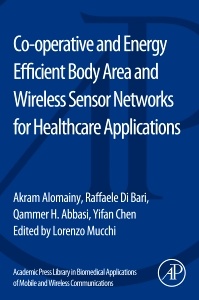Co-operative and Energy Efficient Body Area and Wireless Sensor Networks for Healthcare Applications
Auteurs : Alomainy Akram, Di Bari Raffaele, Abbasi Qammer H., Chen Yifan

With the advances in small and low-cost radio transceivers and RF front-ends development, the possibility of applying ubiquitous and non-invasive sensors integrated into user’s daily clothing and living activities seems more feasible. The ability to share data increases the usefulness of personal information devices, providing features not possible with independent isolated devices. Current wireless sensor solutions are limited in that they do not provide the means to overcome obstacles and shadowing of propagating radio waves. Thus for reliable communications an increase in power consumption is required, reducing battery life. This book addresses the limitations outlined above by designing efficient and compact antenna systems. These systems will be cooperative and also aware of the surrounding environment and neighboring units, providing efficient and low power wireless connectivity for personal area network (PAN) and body area network (BAN) applications.
- Analysis of wearable antenna design and performance
- Addresses the Influence of body-worn antennas on radio channels and radio device performance from a power and error rate perspective.
- Cooperative networking principles applied to body area networks, showing the pros and cons of such concepts
- Real life case scenarios using ECG sample signals for potential application to healthcare monitoring.
Introduction 1. Introduction to Body Area and Wireless Sensor Networks 2. Frequency Band Allocation for Body Area Networks 3. Antenna Design Requirements for Wireless BAN and WSNs 4. Cooperative and Low-Power Wireless Sensor Networks for Body-Centric Applications 5. Design of Body-Worn Radar-Based Sensors for Vital Sign Monitoring 6. Conclusions
- Analysis of wearable antenna design and performance
- Addresses the Influence of body-worn antennas on radio channels and radio device performance from a power and error rate perspective.
- Cooperative networking principles applied to body area networks, showing the pros and cons of such concepts
- Real life case scenarios using ECG sample signals for potential application to healthcare monitoring.
Date de parution : 03-2014
Ouvrage de 60 p.
15.2x22.8 cm
Disponible chez l'éditeur (délai d'approvisionnement : 14 jours).
Prix indicatif 39,45 €
Ajouter au panier


